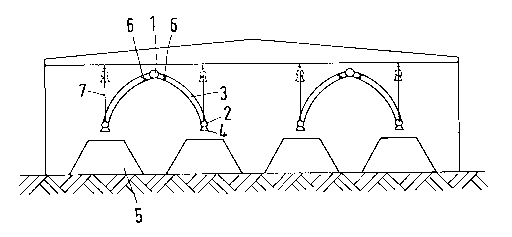Une partie des informations de ce site Web a été fournie par des sources externes. Le gouvernement du Canada n'assume aucune responsabilité concernant la précision, l'actualité ou la fiabilité des informations fournies par les sources externes. Les utilisateurs qui désirent employer cette information devraient consulter directement la source des informations. Le contenu fourni par les sources externes n'est pas assujetti aux exigences sur les langues officielles, la protection des renseignements personnels et l'accessibilité.
L'apparition de différences dans le texte et l'image des Revendications et de l'Abrégé dépend du moment auquel le document est publié. Les textes des Revendications et de l'Abrégé sont affichés :
| (12) Demande de brevet: | (11) CA 2148873 |
|---|---|
| (54) Titre français: | DISPOSITIF DE VENTILATION INFORMATISE POUR CHAMBRE DE DECOMPOSITION |
| (54) Titre anglais: | COMPUTER-CONTROLLED EXTRACTION DEVICE FOR ROTTING HALLS |
| Statut: | Réputée abandonnée et au-delà du délai pour le rétablissement - en attente de la réponse à l’avis de communication rejetée |
| (51) Classification internationale des brevets (CIB): |
|
|---|---|
| (72) Inventeurs : |
|
| (73) Titulaires : |
|
| (71) Demandeurs : |
|
| (74) Agent: | ROBIC AGENCE PI S.E.C./ROBIC IP AGENCY LP |
| (74) Co-agent: | |
| (45) Délivré: | |
| (22) Date de dépôt: | 1995-05-08 |
| (41) Mise à la disponibilité du public: | 1995-11-27 |
| Licence disponible: | S.O. |
| Cédé au domaine public: | S.O. |
| (25) Langue des documents déposés: | Anglais |
| Traité de coopération en matière de brevets (PCT): | Non |
|---|
| (30) Données de priorité de la demande: | ||||||
|---|---|---|---|---|---|---|
|
The present invention relates to a computer-controlled
extraction device for rotting halls, comprising one or
more main collecting lines (1) which are each connected
via a flexible hose (3) to one or more extraction
modules (2), wherein one extraction module (2) has one
or more extraction hoods (4), the main collecting lines
(1) have a butterfly valve (6) at the connection point
of a flexible hose (3), the modules (2) are adjustable
via lifting gear (7) and the main collecting lines (1)
are connected to an exhaust air fan.
Note : Les revendications sont présentées dans la langue officielle dans laquelle elles ont été soumises.
Note : Les descriptions sont présentées dans la langue officielle dans laquelle elles ont été soumises.

2024-08-01 : Dans le cadre de la transition vers les Brevets de nouvelle génération (BNG), la base de données sur les brevets canadiens (BDBC) contient désormais un Historique d'événement plus détaillé, qui reproduit le Journal des événements de notre nouvelle solution interne.
Veuillez noter que les événements débutant par « Inactive : » se réfèrent à des événements qui ne sont plus utilisés dans notre nouvelle solution interne.
Pour une meilleure compréhension de l'état de la demande ou brevet qui figure sur cette page, la rubrique Mise en garde , et les descriptions de Brevet , Historique d'événement , Taxes périodiques et Historique des paiements devraient être consultées.
| Description | Date |
|---|---|
| Inactive : CIB enlevée | 2021-07-06 |
| Inactive : CIB enlevée | 2021-03-30 |
| Inactive : CIB attribuée | 2021-03-30 |
| Inactive : CIB attribuée | 2021-03-02 |
| Inactive : CIB en 1re position | 2021-03-02 |
| Inactive : CIB attribuée | 2021-03-02 |
| Inactive : CIB expirée | 2020-01-01 |
| Inactive : CIB expirée | 2020-01-01 |
| Inactive : CIB enlevée | 2019-12-31 |
| Inactive : CIB enlevée | 2019-12-31 |
| Inactive : CIB expirée | 2018-01-01 |
| Inactive : CIB enlevée | 2017-12-31 |
| Inactive : CIB de MCD | 2006-03-11 |
| Inactive : CIB de MCD | 2006-03-11 |
| Inactive : CIB de MCD | 2006-03-11 |
| Inactive : CIB de MCD | 2006-03-11 |
| Le délai pour l'annulation est expiré | 2001-05-08 |
| Demande non rétablie avant l'échéance | 2001-05-08 |
| Réputée abandonnée - omission de répondre à un avis sur les taxes pour le maintien en état | 2000-05-08 |
| Réputée abandonnée - omission de répondre à un avis sur les taxes pour le maintien en état | 1997-05-08 |
| Inactive : Demande ad hoc documentée | 1997-05-08 |
| Demande publiée (accessible au public) | 1995-11-27 |
| Date d'abandonnement | Raison | Date de rétablissement |
|---|---|---|
| 2000-05-08 | ||
| 1997-05-08 |
Le dernier paiement a été reçu le 1999-04-27
Avis : Si le paiement en totalité n'a pas été reçu au plus tard à la date indiquée, une taxe supplémentaire peut être imposée, soit une des taxes suivantes :
Les taxes sur les brevets sont ajustées au 1er janvier de chaque année. Les montants ci-dessus sont les montants actuels s'ils sont reçus au plus tard le 31 décembre de l'année en cours.
Veuillez vous référer à la page web des
taxes sur les brevets
de l'OPIC pour voir tous les montants actuels des taxes.
| Type de taxes | Anniversaire | Échéance | Date payée |
|---|---|---|---|
| TM (demande, 3e anniv.) - générale | 03 | 1998-05-08 | 1998-04-22 |
| TM (demande, 4e anniv.) - générale | 04 | 1999-05-10 | 1999-04-27 |
Les titulaires actuels et antérieures au dossier sont affichés en ordre alphabétique.
| Titulaires actuels au dossier |
|---|
| METALLGESELLSCHAFT AKTIENGESELLSCHAFT |
| Titulaires antérieures au dossier |
|---|
| FRIEDEL VOLLMER |
| LOTHAR DOLLE |